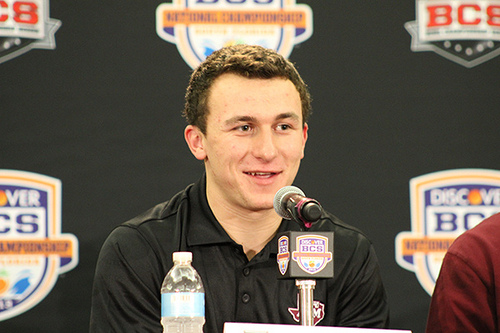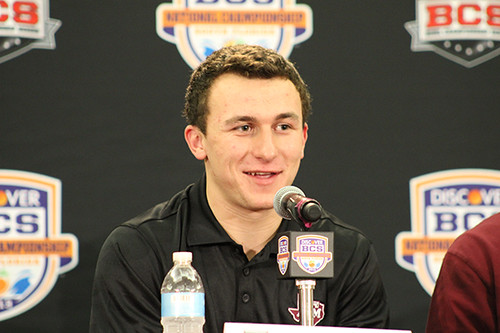When news broke Monday that Texas A&M’s Heisman-winning quarterback “Johnny Football” Manziel is taking only online courses this semester, I started to actually laugh out loud.
The idea that Stanford competes with universities like Texas A&M on the playing field is nothing short of absurd. It’s getting to a point that I’m not even sure Stanford’s teams are playing the same sport as the rest of the NCAA’s Division I universities.
Can you even imagine Andrew Luck taking online classes after his breakout junior campaign so that he could stay away from all of the attention and just focus on his football training?
The reality on this campus is very different. Each of the last two years, I traveled with Stanford women’s basketball during postseason play. I can vividly remember a moment two years ago at the then-Pac-10 championship in Los Angeles, which took place during winter quarter’s “Dead Week”—the week right before finals start.
I came down to the lobby of our hotel for a snack, and more importantly, a break from the final paper that had been tormenting me throughout the evening. When I sat down on the couch to relax, I began to talk to three of the players on the team who were all sitting with their laptops open.
They weren’t on Facebook, they were finishing problem sets and papers, just like me. In about 15 hours, Stanford would take on UCLA for the Pac-10 title—and win—but first came school.
Later that year, Stanford baseball traveled to Fullerton for the NCAA Regional during finals week. Players were sometimes forced to take finals immediately following a game, into the wee hours of the morning, to fulfill their academic requirements. I can’t imagine trying to stay focused and rested while balancing finals and postseason play.
Every time I read a story like the one on Manziel’s online classes, I find it harder to believe that anyone else has to balance anything nearly as difficult as what Stanford student-athletes do.
Let me be fair to Manziel here. Assuming that his reasoning is true—Manziel told Brent Zwenerman of the San Antonio Express-News that he tried to take an on-campus English class but his classmates’ reaction to him became “more of a big deal” than he thought—Manziel is not to blame for his choice to stick to just online classes.
This is one of those rare cases where, in fact, the athlete is the victim, not the beneficiary, of the hero-worshipping culture of student bodies and fanbases in general in SEC and Big-12 country.
But Manziel didn’t fight back—he was content to go through the motions with his online classes while finishing out the remainder of his three-year holding pattern to NFL stardom.
And Texas A&M was happy to let him do so. As long as Johnny Football brings his 2012 magic into the 2013 season, no Aggie will complain about his questionable status as an online student-athlete.
I spoke with senior water polo player Melissa Seidemann on Wednesday about her transition back to Stanford after a year off to train with the U.S. Senior National Team for the London Olympics—she won a gold medal with the team—and I got a very different view on education.
“I took 20 units fall quarter, I’m taking 20 units this quarter, just so I can have a little bit of a lighter spring, but it’s really given me perspective in what I want to do with my future, so that’s been cool,” Seidemann said. “I’ve gained a new appreciation for the classes that I can take here and explore my passion.”
I know that I’m not shocking anyone with the notion that Stanford student-athletes, for the most part, have much more passion towards academics than the average NCAA student-athlete. I also know that I wouldn’t be the first person to remind readers how difficult it is to recruit to Stanford due to the academic standards.
But I don’t think many people realize that this academic challenge doesn’t simply disappear by Stanford recruiting smarter and more academically focused student-athletes.
I know for a fact that my coverage of Stanford Athletics is better when I’m taking a lighter course load. I’ve had games on air with KZSU when schoolwork has gotten in the way of my performance. The week of Stanford football’s game against Arizona, midterms got in the way of my preparation time—and my sleep time—and it definitely showed early on in my broadcast.
So, though I laughed at first when I heard about Johnny Manziel taking online classes or the 2001 Georgia Basketball “class,” these stories make me nervous. How long can Stanford continue to perform at the highest athletic level while maintaining passion and success in the classroom?
As the financial stakes of college athletics continue to grow, I see universities trying to make it even easier, and certainly not harder, for their student-athletes to focus on the athlete half of their titles.
I don’t know if there’s anything Stanford can do to avoid this, besides pressure the NCAA to try take action. That might be Stanford’s only chance to avoid becoming yet another victim—joining the ranks of Big East basketball, the Texas/Texas A&M rivalry and some of the best aspects of ACC basketball—of the new landscape of college athletics.
How much homework do you think Sam Fisher had the night he wrote this column? Let him know at safisher ‘at’ stanford.edu and follow him on Twitter @SamFisher908.

